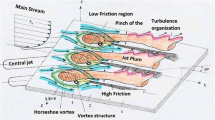Abstract
This work presents a simplified model for the determination of the engine power as a function of the residual stress using quench parameters by forced convection and introduces the necessary empirical equations of integral heat and mass transfer coefficients suggested by Martin (1977). For a residual stress dependent production of thermally tempered glasses, float glasses were thermally tempered due to heat treatment of the glass panes with different heat transfer coefficients. In the method presented, quench parameters for determining the engine power required to reach the target residual stresses are taken into account. The plausibility of the model is checked on the basis of experimental data.











Similar content being viewed by others
References
Aronen, A., Karvinen, R.: Effect of glass temperature before cooling and cooling rate on residual stresses in tempering. In: Glass Structures and Engineering, no. Rantala 2015 (2017)
Aronen, A.: Modelling of Deformations and Stresses in Glass Tempering. Ph.D. dissertation (2012)
Bernard, F., Daudeville, L., René, G.: Prediction of residual stresses near joints in tempered glass plates| Calcul des contraintes résiduelles dans les zones d’assemblage de plaques en verre trempé. Mec. Ind. 6(1), 55–64 (2005)
Daudeville, L., Bernard, F., Gy, R.: Residual stresses near holes in tempered glass plates. Mater. Sci. Forum 404–407, 43–48 (2002)
Fineberg, J.: The dynamics of rapidly moving tensile cracks in brittle amorphous material. In: Shukla, A. (ed.) Dynamic Fracture Mechanics, pp. 104–146. World Scientific, Singapore (2006). https://doi.org/10.1142/9789812773326_0003
Laufs, W., Sedlacek, G.: Stress distribution in thermally tempered glass panes near the edges, corners and holes. Part 1. Temperature distributions during the tempering process of glass panes. Glass Sci. Technol. Frankf. Main 72(1), 7–14 (1999)
Laufs, W., Sedlacek, G.: Stress distribution in thermally tempered glass panes near the edges, corners and holes: Part 2. Distribution of thermal stresses. Glass Sci. Technol. Frankf. Main 72(2), 42–48 (1999)
Martin, H.: Heat and Mass Transfer Between Impinging Gas Jets and Solid Surfaces. In: Hartnett J. P. & Irvine T. F. (eds.) Advances in Heat Transfer, pp. 1–60. Elsevier, New York (1977). https://doi.org/10.1016/S0065-2717(08)70221-1
Narayanaswamy, O.S.: A model of structural relaxation in glass. J. Am. Ceram. Soc. 54(10), 491–498 (1971)
Narayanaswamy, O.S., Gardon, R.: Calculation of Residual stresses in glass. J. Am. Ceram. Soc. 52(10), 554–558 (1969)
Nielsen, J.H.: Tempered Glass: Bolted Connections and Related Problems. Ph.D. dissertation, Technical University of Denmark (2009)
Nielsen, J.H., Olesen, J.F., Poulsen, P.N., Stang, H.: Finite element implementation of a glass tempering model in three dimensions. Comput. Struct. 88(17–18), 963–972 (2010)
Pourmoghaddam, N., Nielsen, J. H., Schneider, J.: Numerical simulation of residual stresses at holes near edges and corners in tempered glass: a parametric study. In: Engineered transparency international conference at Glasstec (2016)
Pourmoghaddam, N., Schneider, J.: Finite-element analysis of the residual stresses in tempered glass plates with holes or cut-outs. Glass Struct. Eng. 3(1), 17–37 (2018). https://doi.org/10.1007/s40940-018-0055-z
Pourmoghaddam, N., Schneider, J.: Experimental investigation into the fragment size of tempered glass. Glass Struct. Eng. 3(2), 167–181 (2018). https://doi.org/10.1007/s40940-018-0062-0
Schabel, W., Martin, H.: Prallströmung. In: VDI-Wärmeatlas, pp. 841–847. Springer, Heidelberg (2013)
Schneider, J.: Festigkeit und Bemessung punktgelagerter Gläser und stoßbeanspruchter Gläser. Ph.D. dissertation, Technische Universität Darmstadt (2001)
Author information
Authors and Affiliations
Corresponding author
Ethics declarations
Conflict of interest
The authors declare that they have no conflict of interest.
Additional information
Publisher's Note
Springer Nature remains neutral with regard to jurisdictional claims in published maps and institutional affiliations.
Rights and permissions
About this article
Cite this article
Pourmoghaddam, N., Schneider, J. Determination of the engine power for quenching of glass by forced convection: simplified model and experimental validation of residual stress levels. Glass Struct Eng 4, 117–125 (2019). https://doi.org/10.1007/s40940-018-0078-5
Received:
Accepted:
Published:
Issue Date:
DOI: https://doi.org/10.1007/s40940-018-0078-5




